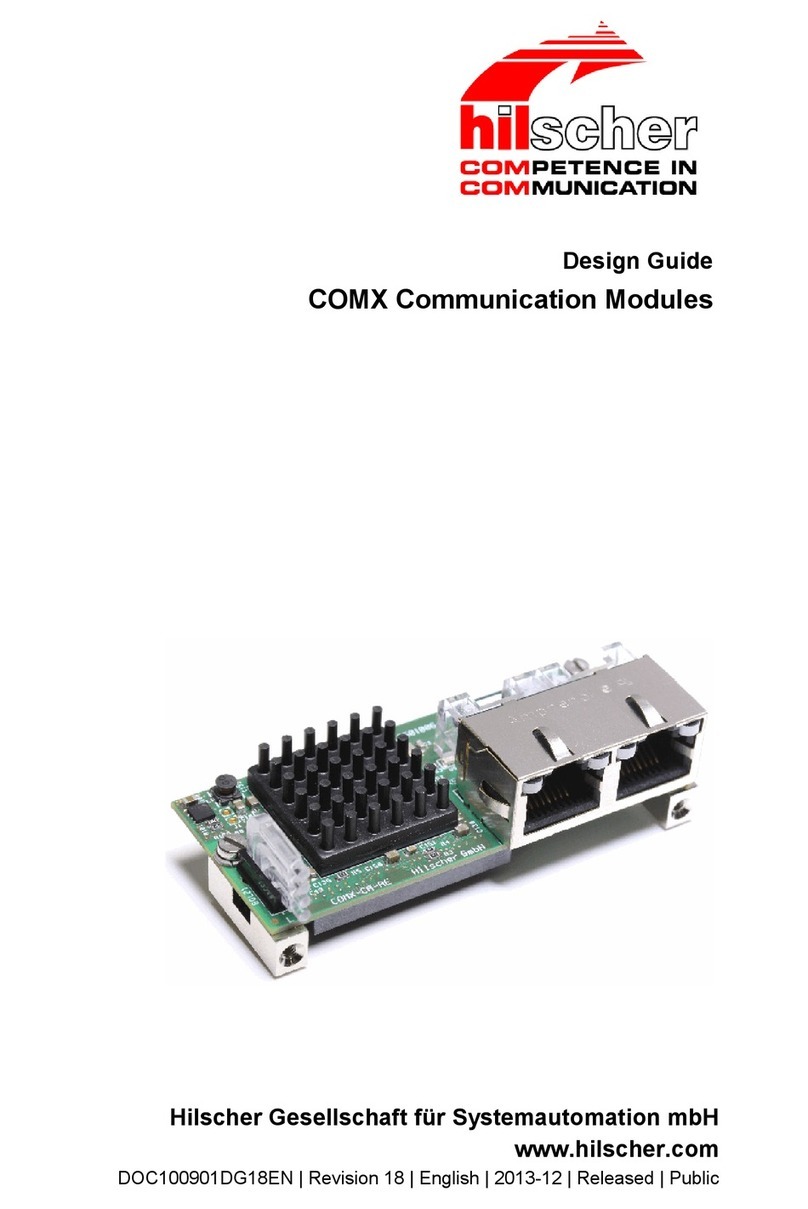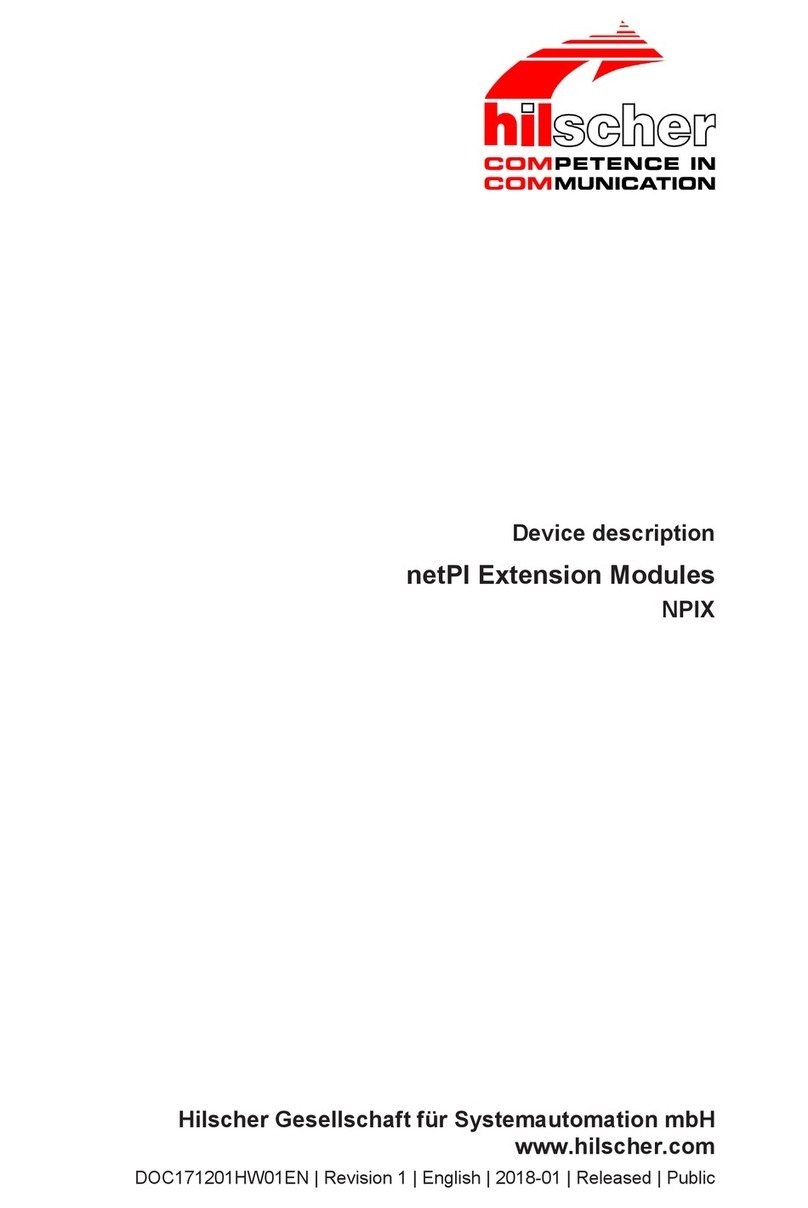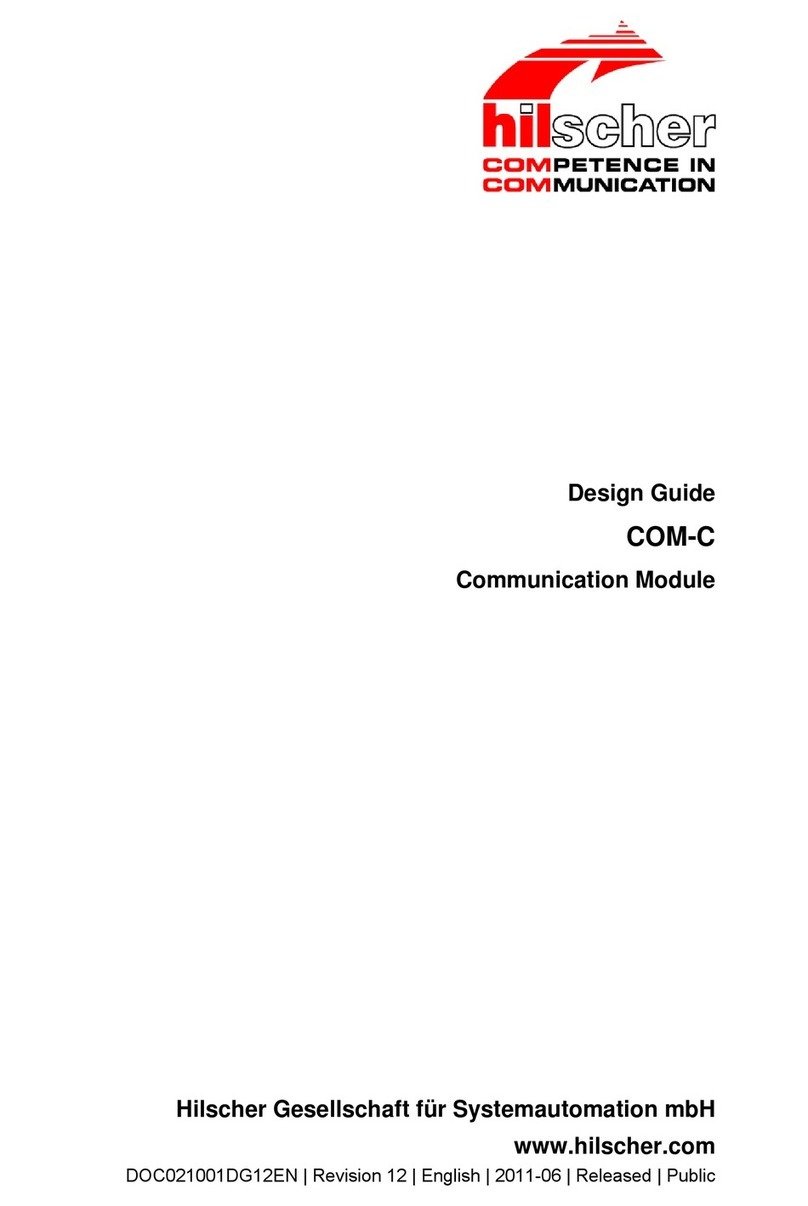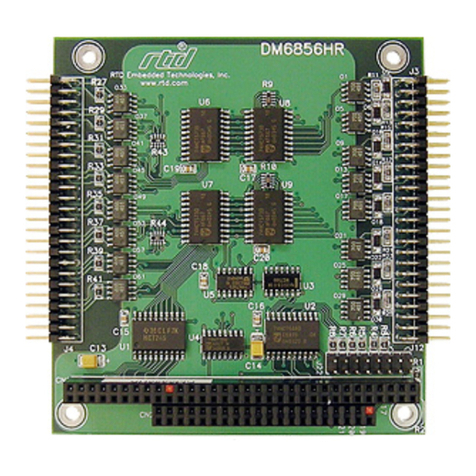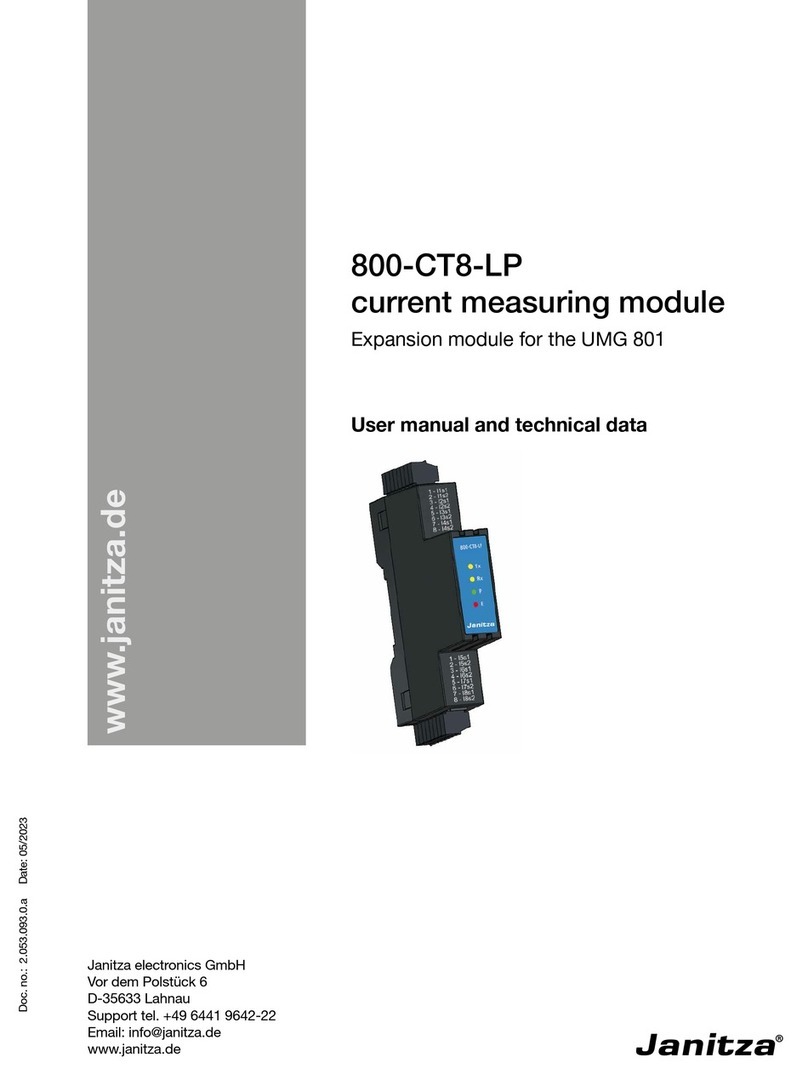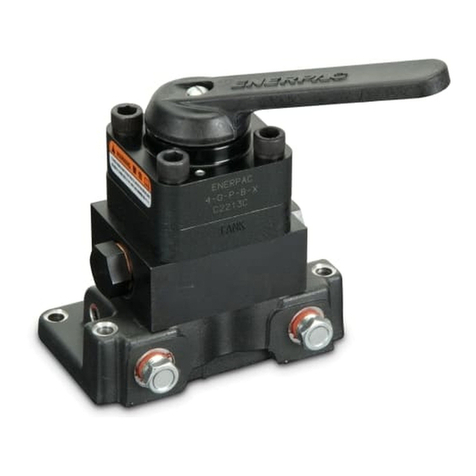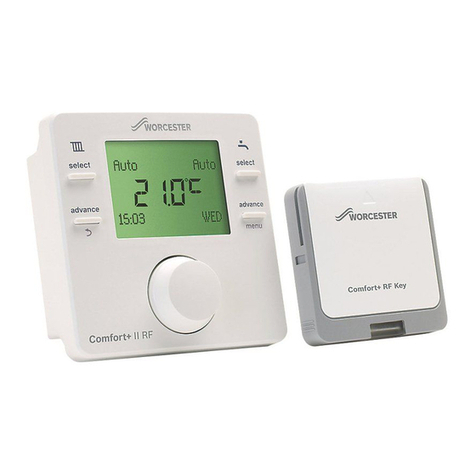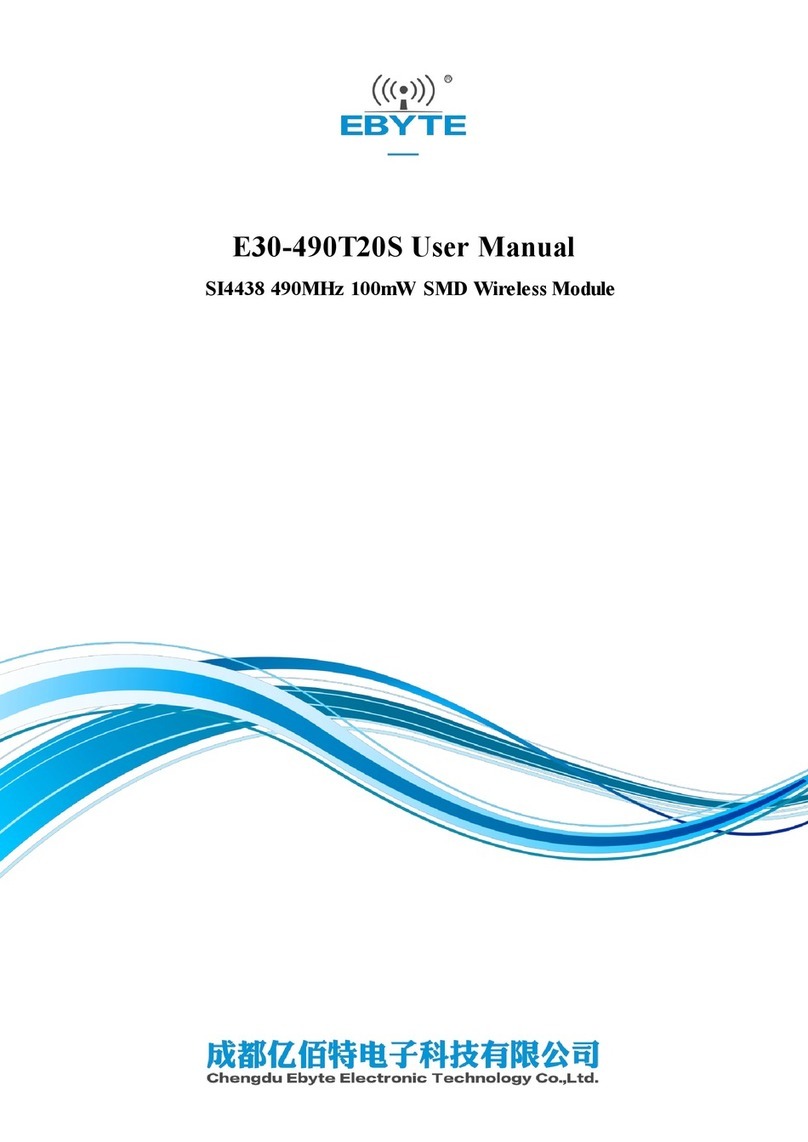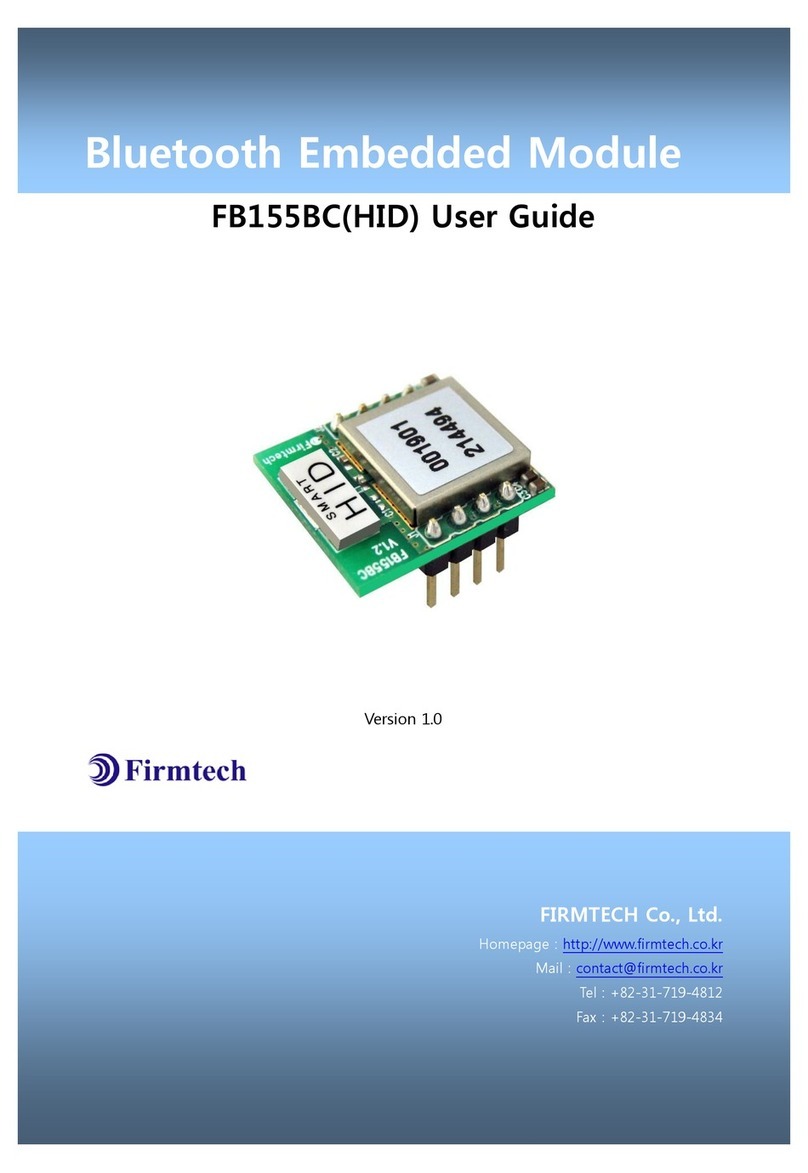hilscher netRAPID 90 Guide

Design guide
netRAPID 90
Chip Carrier
Hilscher Gesellschaft für Systemautomation mbH
www.hilscher.com
DOC190601DG01EN | Revision 1 (Draft 10) | English | 2019-09 | Preliminary | Public

Table of contents 2/108
Table of contents
1 Introduction .............................................................................................................................. 5
1.1 About this document ........................................................................................................5
1.2 List of revisions ................................................................................................................5
1.3 References to documents ................................................................................................5
2 Product concept and overview............................................................................................... 6
2.1 Concept netRAPID 90......................................................................................................6
2.1.1 Companion solution: Preloaded communication module.................................. 6
2.1.2 Stand-alone solution: Programming platform like a netX chip .......................... 7
2.1.3 One design with different memory options........................................................ 8
2.2 Overview netX90 base technology...................................................................................9
2.2.1 Features netX90 ............................................................................................... 9
2.2.2 Internal structure of the netX90......................................................................... 9
2.2.3 Security concept netX90 and netX90 based products .................................... 10
2.2.4 Software concept netX90 and netX90 based products................................... 10
2.3 Overview netRAPID 90 ..................................................................................................12
2.3.1 Features netRAPID 90.................................................................................... 12
2.3.2 Requirements for design-in............................................................................. 12
2.3.3 Connections overview..................................................................................... 13
2.3.4 Benefits of netRAPID90 .................................................................................. 14
2.4 netRAPID 90 variants.....................................................................................................15
2.4.1 Overview netRAPID 90 products .................................................................... 15
2.4.2 Memory options .............................................................................................. 15
2.4.3 Preloaded vs. open platform ........................................................................... 16
2.5 Solutions for typical applications ....................................................................................17
2.5.1 Companion solution providing a fixed layout .................................................. 17
2.5.2 Stand-alone solution providing a flexible layout.............................................. 17
3 Mechanics............................................................................................................................... 18
3.1 Dimension ......................................................................................................................18
3.2 Design guidelines for the host system ...........................................................................19
3.2.1 Footprint.......................................................................................................... 19
3.2.2 Thermal behavior and thermal pad ................................................................. 20
3.2.3 VIAs and signal fan out underneath the netRAPID device ............................. 20
3.3 Tempering, storage and soldering .................................................................................21
3.4 Matrix label.....................................................................................................................22
4 Electrical aspects common for both solutions ................................................................... 23
4.1 Location of pins ..............................................................................................................23
4.2 General signals ..............................................................................................................23
4.2.1 Supply voltage ................................................................................................ 23
4.2.2 Reset signals .................................................................................................. 24
4.2.3 Boot signal and boot options........................................................................... 25
4.3 Real-Time Ethernet interface .........................................................................................27
4.3.1 Interface description........................................................................................ 27
4.3.2 Design recommendations ............................................................................... 28
4.4 Diagnostic interfaces......................................................................................................31
4.4.1 Serial interface – UART .................................................................................. 31
4.4.2 JTAG Debugging interface.............................................................................. 32
netRAPID 90 | Design guide
DOC190601DG01EN | Revision 1 (Draft 10) | English | 2019-09 | Preliminary | Public
© Hilscher 2019

Table of contents 3/108
4.5 LED Signals ...................................................................................................................33
4.5.1 MultiLED concept............................................................................................ 33
4.5.2 LED overview.................................................................................................. 33
4.5.3 System LED (SYS LED) ................................................................................. 34
4.5.4 LEDs COM0 and COM1 ................................................................................. 35
4.5.5 Link/Activity LEDs ........................................................................................... 35
5 Electrical aspects for the companion solution ................................................................... 37
5.1 Pin assignment...............................................................................................................37
5.2 Block diagram for the companion solution .....................................................................40
5.3 Host interface .................................................................................................................41
5.3.1 Serial dual-port memory mode........................................................................ 41
5.3.2 Design recommendation ................................................................................. 42
5.4 Fieldbus interface...........................................................................................................43
5.4.1 PROFIBUS-DP ............................................................................................... 43
5.4.2 DeviceNet ....................................................................................................... 43
5.5 SYNC0/1 signals ............................................................................................................44
6 Electrical aspects for the stand-alone solution .................................................................. 46
6.1 Pin assignment...............................................................................................................46
6.2 Block diagram for the stand-alone solution ....................................................................50
6.3 General signals ..............................................................................................................51
6.3.1 Brown-out detection ........................................................................................ 51
6.4 MMIO signals .................................................................................................................51
6.5 ADCs..............................................................................................................................52
7 Evaluation Board ................................................................................................................... 55
7.1 Positions of elements - Evaluation board NRPEB H90-RE............................................55
7.2 Operating elements of the evaluation Board..................................................................57
7.2.1 Switches and buttons...................................................................................... 57
7.2.2 Jumper field X501 ........................................................................................... 63
7.3 Interfaces .......................................................................................................................64
7.3.1 Fieldbus interface (X300)................................................................................ 64
7.3.2 JTAG interface (X301) .................................................................................... 65
7.3.3 Extension interface (X302).............................................................................. 66
7.3.4 COM IO (X303) ............................................................................................... 67
7.3.5 Extension interface (X304).............................................................................. 68
7.3.6 SYNC0/1 signals (X305) ................................................................................. 69
7.3.7 SYNC0/1 signals (X306) ................................................................................. 70
7.3.8 Reset out signal (X307) .................................................................................. 71
7.3.9 UART interface (X308).................................................................................... 72
7.3.10 SQI interface (X309) ....................................................................................... 73
7.3.11 Ethernet interface (X400)................................................................................ 74
7.3.12 ADC reference voltage VREF-ADC (X500) .................................................... 75
7.3.13 SPM Interface (X600) ..................................................................................... 75
7.3.14 USB interface for SPM - NRPEB H90-RE (X700)........................................... 76
7.3.15 Power connector (X800) ................................................................................. 77
7.4 LEDs ..............................................................................................................................78
7.4.1 SYS LED (P300) ............................................................................................. 79
7.4.2 COM0 LED (P400).......................................................................................... 80
7.4.3 COM1 LED (P401).......................................................................................... 80
7.4.4 User LEDs (P500-P503) ................................................................................. 81
netRAPID 90 | Design guide
DOC190601DG01EN | Revision 1 (Draft 10) | English | 2019-09 | Preliminary | Public
© Hilscher 2019

Table of contents 4/108
7.4.5 Link/Activity0/1 (X400-C/D)............................................................................. 82
8 Accessories............................................................................................................................ 83
8.1 NXHX Fieldbus interface modules .................................................................................83
8.1.1 PROFINET-DP Interface Module NXHX-DP................................................... 84
8.1.2 CANopen Interface Module NXHX-CO ........................................................... 85
8.1.3 DeviceNet Interface Module NXHX-DN .......................................................... 85
8.1.4 CC-Link Interface Module NXHX-CC.............................................................. 86
8.2 NXHX RS232 interface modules....................................................................................87
8.2.1 RS232 interface module ................................................................................. 88
9 Schematics ............................................................................................................................. 89
9.1 NRPEB H90-RE - Front view .........................................................................................89
9.2 NRPEB H90-RE ETHERNET.........................................................................................90
9.3 NRPEB H90-RE FTDI ....................................................................................................91
9.4 NRPEB H90-RE IO ADC................................................................................................92
9.5 NRPEB H90-RE NETRAPID..........................................................................................93
9.6 NRPEB H90-RE POWER_SUPPLY ..............................................................................94
9.7 NRPEB H90-RE SWITCHING MATRIX.........................................................................95
9.8 NRPEB H90-RE SYSTEM .............................................................................................96
10 Bill of material ........................................................................................................................ 97
10.1 Overview ........................................................................................................................97
10.2 NRPEB H90-RE .............................................................................................................97
11 Appendix............................................................................................................................... 100
11.1 Legal notes...................................................................................................................100
Contacts................................................................................................................................ 108
netRAPID 90 | Design guide
DOC190601DG01EN | Revision 1 (Draft 10) | English | 2019-09 | Preliminary | Public
© Hilscher 2019

Introduction 5/108
1 Introduction
1.1 About this document
This design guide describes the mechanical and electrical interfaces of
netRAPID 90. This document also includes the description of the netRAPID
90 Evaluation Board.
1.2 List of revisions
Rev Date Name Chapter Revision
1 2019-09-11 RGö/
CHu / HHe
All Created.
Table1: List of revisions
1.3 References to documents
This document refers to the following other documents:
Hilscher Gesellschaft für Systemautomation mbH: Getting Started Guide,
Serial Dual-Port Memory Interface with netX, Revision 4, English, 2015.
Hilscher Gesellschaft für Systemautomation mbH: Design-In Guide,
netX90, Revision 4, Document ID DOC180501DG04EN, English, 2018-19.
Hilscher Gesellschaft für Systemautomation mbH: Technical Data
Reference Guide, netX90, Revision 3, Document ID
DOC160609TRG03EN, English, 2017-19.
netRAPID 90 | Design guide
DOC190601DG01EN | Revision 1 (Draft 10) | English | 2019-09 | Preliminary | Public
© Hilscher 2019

Product concept and overview 6/108
2 Product concept and overview
2.1 Concept netRAPID 90
The architecture of the netRAPID 90 half-size chip carrier is based on the
netX 90 technology and provides a scalable platform for a wide range of
application scenarios.
You can use the netRAPID 90 as
·a companion solution with host interface (application is executed on
the host CPU)
·a stand-alone solution with a single chip (application is executed on
the APP CPU of netX 90)
On top netRAPID 90 is the perfect way for rapid prototyping of netX90 and
one can easily migrate to a real chip-design after a ramp-up phase.
2.1.1 Companion solution: Preloaded communication module
You can use netRAPID 90 as companion solution in the style of a
communication module to be connected with a host CPU.
In this scenario, netRAPID 90 comes preloaded with a communication
protocol and is ready to use. For this approach, no netX licence or support
agreement is required.
For the companion solution, no netX licence or support contracts are
required.
In the preloaded version, the pin assignment is fixed to certain functionality:
·Real-Time Ethernet or Fieldbus Slave
·SPI interface to the host CPU
·LEDs (COM0, COM1, Link/Activity 0/1)
·SYNC0/1
·UART Diagnosis
·+3.3V, GND
Note:
For more information, see section Companion solution providing a
fixed layout [}page17].
netRAPID 90 | Design guide
DOC190601DG01EN | Revision 1 (Draft 10) | English | 2019-09 | Preliminary | Public
© Hilscher 2019

Product concept and overview 7/108
2.1.2 Stand-alone solution: Programming platform like a netX chip
You can use netRAPID 90 in a stand-alone solution without any host. This
use case can be considered as nearly identical to the direct use of a netX
90 chip.
The pin assignment is flexible and can be adapted by the customer
according to his or her needs by using the tool netX Studio CDT.
For this approach, a netX license and support agreement as well as the
purchase of appropriate protocol stacks are required.
In this scenario, the netRAPID 90 is provided as a pure hardware-platform.
Note:
For more information, see section Stand-alone solution:
Programming platform like a netX chip [}page7].
To reduce production costs at the OEM, Hilscher optionally offers the
service to supply netRAPID 90 preloaded with customer specific content.
For further details about this service please contact the Hilscher sales
team.
netRAPID 90 | Design guide
DOC190601DG01EN | Revision 1 (Draft 10) | English | 2019-09 | Preliminary | Public
© Hilscher 2019

Product concept and overview 8/108
2.1.3 One design with different memory options
A netRAPID 90 is a scalable platform for various use cases, from pure
communication interface up to intelligent field device with integration
customer application. It is a single hardware design, which comes in
different memory options and subsequent different software functionality:
·netRAPID 90 with netX90-internal memory only (NRP H90-RE)
·netRAPID 90 with 8 MB SQI Flash and 8 MB SDRAM (NRP H90-RE
\F8D8)
Depending on the available memory size, the following communication
functionality can be applied:
Basic communication functionality for small footprints, low cost and function
optimized slave devices:
·Using netX90 internal memory only
·Channel 0: Real-Time Ethernet or Fieldbus Slave
·Channel 1: Network Services e.g. TCP socket or NDIS
·Basic WebServer
·Configuration via packets only
Full featured firmware with maximum functionality
·Using external SDRAM and SQI Flash memory
·Channel 0: Real-Time Ethernet or Fieldbus Slave
·Channel 1: Network Services e.g. TCP socket or NDIS
·Future option: Channel 2: IOT Communication (e.g. OPC UA Server,
MQTT Client)
·Basic WebServer + Custom web content
·Configuration via packets + Configuration Tool Communication Studio
·Future option: Security functions
Note:
For detailed functionality, please refer to the technical data of the
corresponding protocol stack within the Hilscher knowledgebase:
https://kb.hilscher.com/display/HILKB/Technologies
netRAPID 90 | Design guide
DOC190601DG01EN | Revision 1 (Draft 10) | English | 2019-09 | Preliminary | Public
© Hilscher 2019

Product concept and overview 9/108
2.2 Overview netX90 base technology
This section describes the netX90 base technology empowering the
netRAPID 90.
2.2.1 Features netX90
The netX 90 is a very powerful and versatile System-on-chip (SoC) for
communication in industrial networks. It offers:
·Smallest multi-protocol SoC with additional Cortex-M4 application
processor:
10 x 10 mm in a 144-pin BGA with 0.8 mm ball pitch
Its innovative architecture allows communication tasks and application
tasks to be executed on separated Cortex-M4 processors.
·Energy-efficient SoC with lowest power loss (<= 1 W).
·Support for all Industrial Ethernet, Fieldbus and IIoT standards providing
a huge amount of flexibility.
·Support for IEEE 1588 functionality
·Rich software ecosystem with state-of-the-art tools
·Common software interface
·Rich peripheral set for application designs
·Integrated security functions for secure field and cloud connectivity.
2.2.2 Internal structure of the netX90
The following figure shows a block diagram of the netX 90.
Figure1: Block diagram of netX90
netRAPID 90 | Design guide
DOC190601DG01EN | Revision 1 (Draft 10) | English | 2019-09 | Preliminary | Public
© Hilscher 2019

Product concept and overview 10/108
2.2.3 Security concept netX90 and netX90 based products
netX 90 offers integrated security functions required for secure field and
cloud functionality. This is achieved by the CryptoCore integrated within
netX 90 which accelerates the SSL/TLS protocols and supports the
following encryption algorithms:
Algorithm Supported key length
RSA 4096
ECC 512
AES 256
SHA 512
Table2: Supported encryption algorithms in netX 90
There is no TPM chip necessary.
2.2.4 Software concept netX90 and netX90 based products
Common software application interface
Figure2: Common software application interface
netRAPID 90 | Design guide
DOC190601DG01EN | Revision 1 (Draft 10) | English | 2019-09 | Preliminary | Public
© Hilscher 2019

Product concept and overview 11/108
The common software application interface of the netX 90 and the netX 90-
based products:
·Based on Hilscher’s Platform strategy
·Three separate COM channels to the application (cyclic and acyclic
data)
Channel Data transferred via channel
Channel 0 Real-Time Ethernet data(→ CIFX API)
Channel 1 TCP socket / Raw Ethernet interface
Channel 2 IIoT data(→ netPROXY API)
Table3: COM channels for cyclic and acyclic data to the application
·Uses same software application interface whether:
– from external host (→ Companion Solution)
– or internal host application (→ Stand-alone Solution)
netRAPID 90 | Design guide
DOC190601DG01EN | Revision 1 (Draft 10) | English | 2019-09 | Preliminary | Public
© Hilscher 2019

Product concept and overview 12/108
2.3 Overview netRAPID 90
2.3.1 Features netRAPID 90
netRAPID 90 offers the following features:
·Ultra-compact design for small field devices
·All major Real-Time Ethernet, Fieldbus and IIoT standards are
supported.
·Built-in security for secure connectivity to field and cloud
·Scalable platform for different use cases
·Preloaded and “ready to use”
·Energy-efficient for extended temperature range
2.3.2 Requirements for design-in
Take the following items into account during the design of your netRAPID
90-based device:
·netRAPID 90
·Magnetics / Transformer
·Connector
·LEDs
·Follow design rules for > 70°C
·SPI Host connection only
·+3.3V and GND
netRAPID 90 | Design guide
DOC190601DG01EN | Revision 1 (Draft 10) | English | 2019-09 | Preliminary | Public
© Hilscher 2019

Product concept and overview 13/108
2.3.3 Connections overview
The figure below illustrates all connections of the netRAPID 90 chip carrier
regardless of the mode they are intended for (companion solution or stand-
alone solution).
Figure3: Block diagram of NRP H90-RE and its interfaces
netRAPID 90 | Design guide
DOC190601DG01EN | Revision 1 (Draft 10) | English | 2019-09 | Preliminary | Public
© Hilscher 2019

Product concept and overview 14/108
For a similar figure showing only the pins relevant for the companion
solution, see section Block diagram for the companion
solution [}page40].
For a similar figure showing only the pins relevant for the strand-alone
solution, see section Block diagram for the stand-alone
solution [}page50].
2.3.4 Benefits of netRAPID90
Ready-to-use netX 90 design
·The fully tested netX 90 design ensures a fast time to market without
development risk
·EOL and part obsolescence handling by Hilscher
·RTE or FB interface in one design
Reduced design and production costs
·PCB complexity and costs are encapsulated. Baseboard can be done in
cost-effective 4 to 6 layer design
·Preloaded with COM Firmware and customer application to reduce
production effort at OEM
Modular and scalable platform
·Different memory options for different applications in a single baseboard
design
·Well prepared for security, TSN and other emerging technologies
·Simpler handling compared to a chip
netRAPID 90 | Design guide
DOC190601DG01EN | Revision 1 (Draft 10) | English | 2019-09 | Preliminary | Public
© Hilscher 2019

Product concept and overview 15/108
2.4 netRAPID 90 variants
2.4.1 Overview netRAPID 90 products
Overview
The following table lists all variants of netRAPID 90, the corresponding
evaluation board and the appropriate firmware:
Products Description Part number
NRPEB H90-RE Evaluation board equipped with soldered-in NRP H90-RE\F8D8 7600.320
NRP H90-RE\F8D8 (TRAY) 56 pieces of NRP H90-RE\F8D8 Chip Carriers (8 Mbyte SQI Flash
and 8 Mbyte SDRAM) preloaded in according variants with firmware
for EtherCAT (NRP H90-RE\F8D8/ECS), EtherNet/IP (NRP H90-RE
\F8D8/EIS) or PROFINET IO (NRP H90-RE\F8D8/PNS)
7690.102
NRP H90-RE (TRAY) 56 pieces of NRP H90-RE Chip Carriers (Internal flash and RAM
only) preloaded in according variants with firmware for EtherCAT
(NRP H90-RE /ECS), EtherNet/IP (NRP H90-RE /EIS) or
PROFINET IO (NRP H90-RE/PNS)
7690.100
NXHX-DP Fieldbus interface module for PROFIBUS-DP 7923.410
NXHX-CO Fieldbus interface module for CANopen 7923.500
NXHX-DN Fieldbus interface module for DeviceNet 7923.510
NXHX-CC Fieldbus interface module for CC-Link 7923.740
Firmware for Real-Time Ethernet (Slave)
NXLFW-ECS Loadable EtherCAT Slave Firmware 7428.120
NXLFW-EIS Loadable EtherNet/IP Adapter Firmware 7428.830
NXLFW-OMB Loadable Open Modbus/TCP Firmware planned
NXLFW-PLS Loadable POWERLINK Controlled Node Firmware planned
NXLFW-PNS Loadable PROFINET IO Device Firmware 7428.851
NXLFW-PNS-IOT Loadable PROFINET IO-Device Firmware and IoT planned
NXLFW-EIS-IOT Loadable Firmware EtherNet/IP Adapter and IoT planned
Firmware for Fieldbus (Slave)
NXLFW-DPS Loadable PROFIBUS-DP Slave Firmware planned
NXLFW-DNS Loadable DeviceNet Slave Firmware planned
Table4: Product overview netRAPID 90
2.4.2 Memory options
As described in section One design with different memory
options [}page8], there are two memory options for the netRAPID 90:
·The NRP H90-RE uses the internal memory of the netX 90 processor
(COM-CPU: 576 kB SRAM, 1024 kB Flash, APP-CPU: 64 kB SRAM,
512 kB Flash).
·The NRP H90-RE\F8D8 uses 8 MB external SQI Flash and 8 MB
external SDRAM additionally to the internal memory of the netX 90
processor.
netRAPID 90 | Design guide
DOC190601DG01EN | Revision 1 (Draft 10) | English | 2019-09 | Preliminary | Public
© Hilscher 2019

Product concept and overview 16/108
2.4.3 Preloaded vs. open platform
2.4.3.1 Evaluation
The evaluation board NRPEB H90-RE is sold in units of 1 piece for test and
development purposes (order no. 7600.320).
2.4.3.2 Preloaded variants of netRAPID 90 (Companion solution)
In the following product variants, netRAPID 90 is available preloaded with
communication protocol:
Packaging unit 1 tray 18 trays 45 trays
NRP H90-RE\PNS 56 pieces \F8D8 1008 pieces \F8D8 2520 pieces \F8D8
NRP H90-RE\EIS 56 pieces \F8D8 1008 pieces \F8D8 2520 pieces \F8D8
NRP H90-RE\ECS 56 pieces \F8D8 1008 pieces \F8D8 2520 pieces \F8D8
NRP H90-RE\DPS
(planned)
56 pieces \F8D8 1008 pieces \F8D8 2520 pieces \F8D8
NRP H90-RE\DNS
(planned)
56 pieces \F8D8 1008 pieces \F8D8 2520 pieces \F8D8
NRP H90-RE\OMB
(planned)
56 pieces \F8D8 1008 pieces \F8D8 2520 pieces \F8D8
NRP H90-RE\PLS
(planned)
56 pieces \F8D8 1008 pieces \F8D8 2520 pieces \F8D8
NRP H90-RE\CCIBS
(planned)
56 pieces \F8D8 1008 pieces \F8D8 2520 pieces \F8D8
Table5: Packaging units netRAPID 90 preloaded with communication protocol
2.4.3.3 Bare netRAPID 90 (Stand-alone solution)
Bare netRAPID 90 chip carriers without any preload are available in the
following packaging unit sizes:
Packaging unit 1 tray 18 tray 45 tray
With external memory 56 pieces \F8D8 1008 pieces \F8D8 2520 pieces \F8D8
Without external
memory
56 pieces \F0D0 1008 pieces \F0D0 2520 pieces \F0D0
Table6: Packaging units netRAPID 90 (bare metal)
For the bare netRAPID 90, the same loadable firmware is available as for
netX90.
A netX license and support agreement as well as a purchase of an
appropriate protocol stack is required!
netRAPID 90 | Design guide
DOC190601DG01EN | Revision 1 (Draft 10) | English | 2019-09 | Preliminary | Public
© Hilscher 2019

Product concept and overview 17/108
2.5 Solutions for typical applications
2.5.1 Companion solution providing a fixed layout
As companion solution, the netRAPID 90 has a fixed pin assignment and
offers the following features:
·Real-time Ethernet or Fieldbus interface
·netRAPID 90 serves for communication only, its application CPU is not
used in this case
·Easy-to-integrate SPI host interface
·LED signals for COM0/1 and Link/Activity 0/1
·Sync 0/1 access
·UART Diagnostic
·Firmware update is done via integrated web server or Diag interface
Depending on the available memory size, different functionality can be
used.
2.5.2 Stand-alone solution providing a flexible layout
As stand-alone solution, the netRAPID 90 provides a flexible pin
assignment as well as separate COM and APP CPU cores. In detail,
netRAPID 90 offers::
·Communication and application have been combined together within
one single module!
·The netX 90 within the netRAPID has two integrated ARM® Cortex®-
M4 cores in order to separate COM and APP.
·Full access to both ARM® Cortex®-M4 cores
·One design supports all Real-time Ethernet slave protocols
·A lot of peripherals for Motion, Encoder, Sensors or IO-Link applications
already included (such as I2C, SPI, UART, CAN, ADC, BiSS, EnDat,
IO-Link)
·Sync 0/1 access
·Ethernet Diagnostic
·Firmware update is done via integrated web server
If you use a firmware with IoT extension on netX 90, then it additionally
offers these features:
·netPROXY based firmware with protocol-independent object interface to
the host
·Product engineering using netX Studio
·Integrated MQTT client and OPC UA server for IoT communication
·Secure boot mechanism based on built-in security functionality
For both requirement profiles, the netRAPID NRP H90-RE\F8D8 with 8 MB
Flash Memory and 8 MB SDRAM is the optimal solution.
netRAPID 90 | Design guide
DOC190601DG01EN | Revision 1 (Draft 10) | English | 2019-09 | Preliminary | Public
© Hilscher 2019

Mechanics 18/108
3 Mechanics
3.1 Dimension
netRAPID 90 chip carrier has the following dimensions:
·Length 31.75mm (corresponding to 1250 mil)
·Width 15.00mm (corresponding to 590 mil)
·Height 4mm.
netRAPID 90 | Design guide
DOC190601DG01EN | Revision 1 (Draft 10) | English | 2019-09 | Preliminary | Public
© Hilscher 2019

Mechanics 19/108
3.2 Design guidelines for the host system
3.2.1 Footprint
The layout for the footprint of the netRAPID 90 on the host system requires
the following dimensions.
1.284 mm
9.5 mm
53
2 3 4 5 6 7 8
35 34 33 32 31 30 29 28
1
3.048 mm
15.875 mm
1.27 mm
1.27 mm 3.062 mm
9
10
11
12
13
14
15
16
17
18
19
20
21
22
23
24
25
26
54
52
51
50
38
49
48
47
46
45
44
43
42
41
40
39
37
36
27
1 mm
1.524 mm
1.27 mm
3.048 mm
Thermal pad
9.5 mm
7.5 mm 7.5 mm
2.4 mm
R 0.5 mm
15.875 mm
15 mm
31.75 mm
1.2 mm
Figure4: Footprint of netRAPID 90
netRAPID 90 | Design guide
DOC190601DG01EN | Revision 1 (Draft 10) | English | 2019-09 | Preliminary | Public
© Hilscher 2019

Mechanics 20/108
3.2.2 Thermal behavior and thermal pad
netRAPID 90 devices have a power consumption of approx. 1 W, which
generates heat. The generated heat must be dissipated to prevent
overheating of the chip. While there is a hard limit for the chip’s junction
temperature at 125°C, above which malfunction and permanent damage
may occur, it is always desired to keep the junction temperature as low as
possible, as a semiconductor’s statistical life time generally decreases with
rising temperature.
Make sure that the case temperature of the netX is always below 100°C,
which is the recommended maximum value for a netX design. This value
was chosen because the FIT-rate for the silicon process, which netX are
based on, shows a significant rise in the temperature range between 100°C
and the absolute maximum junction temperature. However, since the
absolute max. junction temperature is 125°C, it is at the device
manufacturer’s discretion if he wants to follow this recommendation or
rather decides to accept a higher junction temperature and trade a
decrease of the MTBF of his devices for a higher temperature range
specification.
netRAPID devices require a thermal pad at the bottom for heat dissipation
to the PCB of the host system.
Note:
You must use a thermal pad on the PCB for the host system. This
is absolutely necessary in order to reach the temperature range for
netRAPID devices.
This results in requirements for the PCB of the host system:
·Use a large copper surface on the PCB of the host system to achieve a
good heat dissipation for the netRAPID 90.
·Don’t place components on the PCB of the host system below the
netRAPID 90 to avoid heat dissipation of other component than
netRAPID 90.
The thermal pad of the netRAPID device must have GND potential.
The figure shows position and size of the thermal pad for netRAPID 90.
3.2.3 VIAs and signal fan out underneath the netRAPID device
Make sure that no vias and no wires are on the PCB of the host system
underneath the netRAPID device.
Important note: Make sure to use the thermal pad. Figures in section
Footprint [}page19] on page 10 [}page19] shows position and size of the
thermal pad for the netRAPID 90.
netRAPID 90 | Design guide
DOC190601DG01EN | Revision 1 (Draft 10) | English | 2019-09 | Preliminary | Public
© Hilscher 2019
Table of contents
Other hilscher Control Unit manuals
Popular Control Unit manuals by other brands

Toshiba
Toshiba IK-TF7U instruction manual
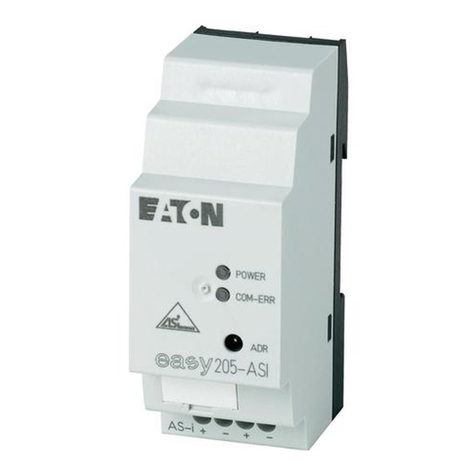
Eaton
Eaton EASY205-ASI Instruction leaflet
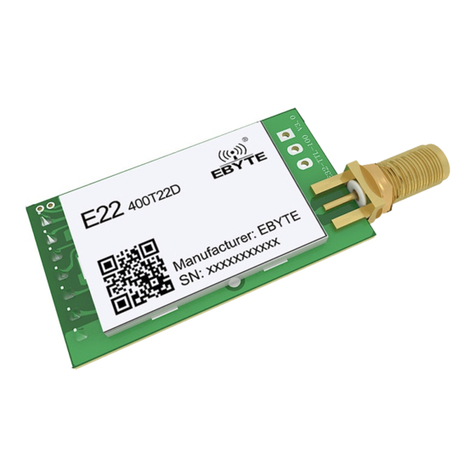
Ebyte
Ebyte E22-400T22D user manual
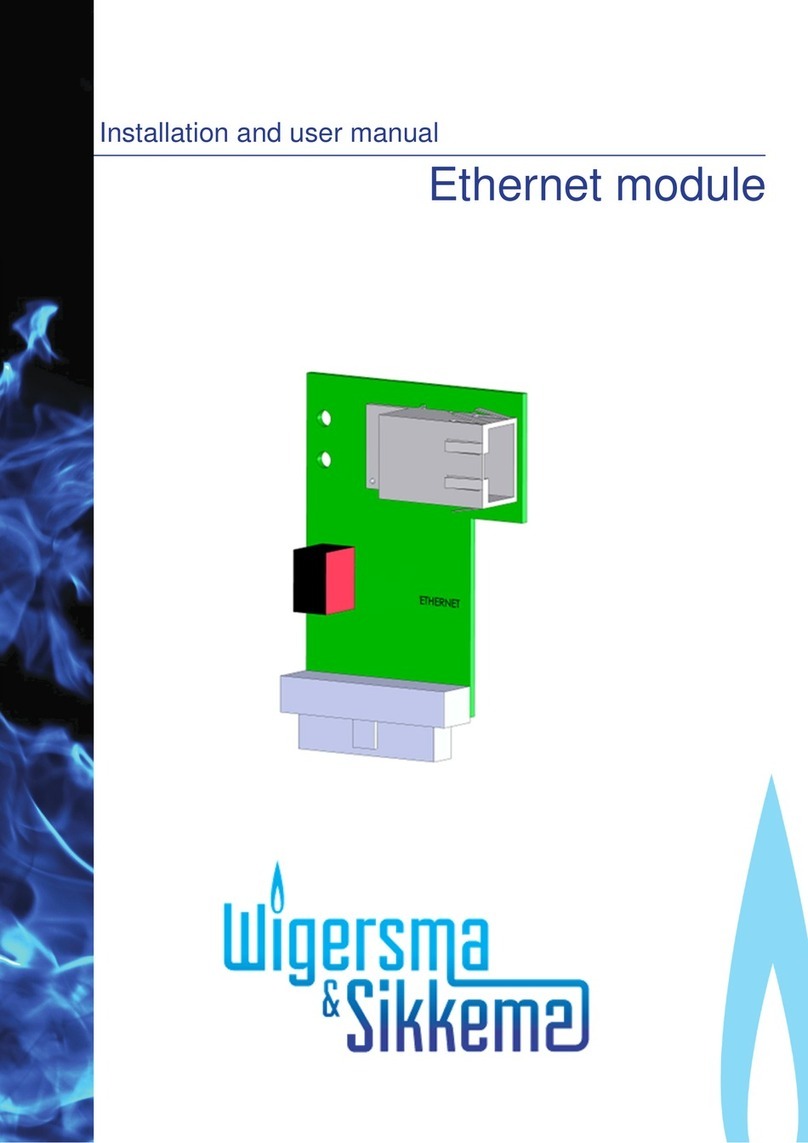
Wigersma & Sikkema
Wigersma & Sikkema Moxa MiiNePort E1 Installation and user manual

Canova
Canova SDSCV9000 operating manual
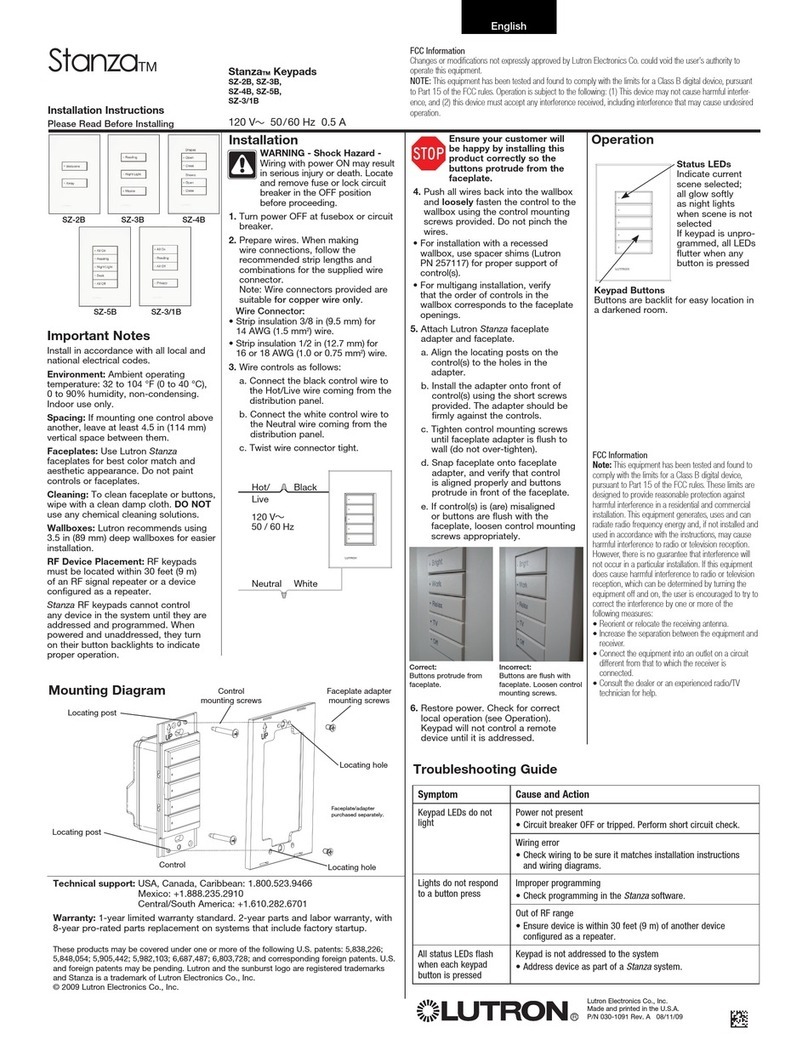
Lutron Electronics
Lutron Electronics Stanza SZ-2B installation instructions
